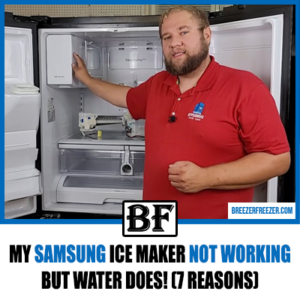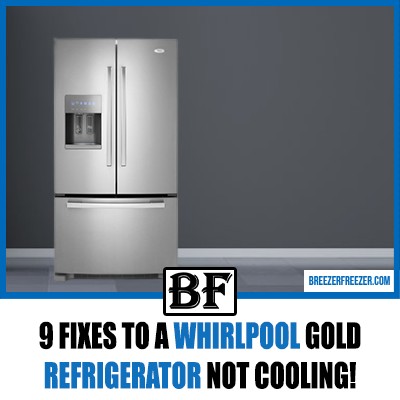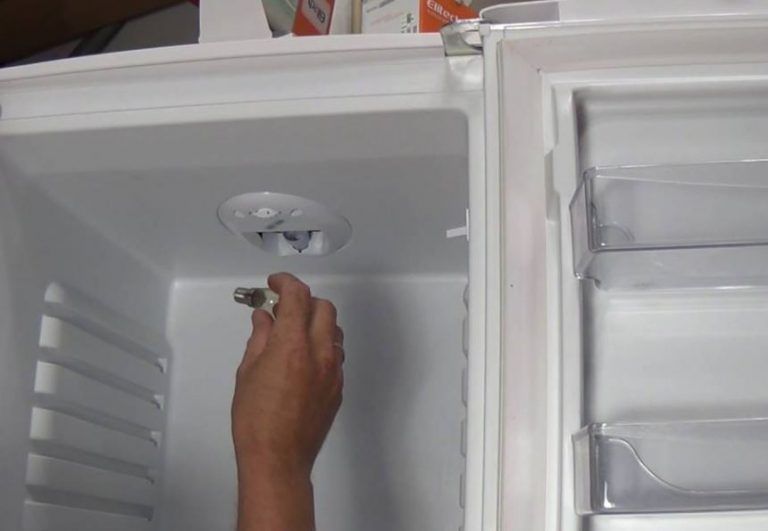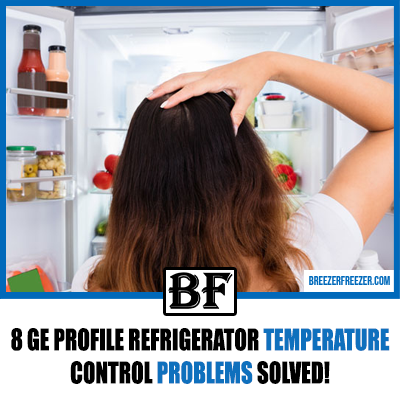My Samsung Ice Maker Not Working But Water Does! (7 Reasons)
When it comes to Samsung ice makers and dispensers, it is not uncommon for them to experience issues together. However, there are instances where the ice maker may stop working while the water dispenser continues to function. If you find yourself facing this problem, there are several potential causes to consider.

One possible reason for your Samsung ice maker not producing ice is that the temperature in the freezer is above 10°F. Additionally, a defective water inlet valve or low water pressure could be contributing factors. Another possibility is that the water line is blocked by ice, the ice maker assembly or motor has malfunctioned, or the ice maker itself is turned off.
While Samsung refrigerators are generally reliable, many users find the ice maker to be a disappointing component. This is often because they lack knowledge of how to troubleshoot it effectively. That’s where this guide comes in handy.
In the following sections, we will explore seven likely causes of ice maker issues and provide solutions that will empower you to troubleshoot the problem on your own. Let’s get started!
Quick Troubleshooting Guide
| Probable Cause | Fix |
| 1. Freezer temperature above 10°F | – Adjust the freezer temperature to 0 – 5°F |
| 2. Defective/clogged water inlet valve | – Replace the inlet valve if it is defective or clogged |
| 3. Low water pressure (under 20 psi) | – Adjust the water pressure to 20 psi or higher |
| 4. Ice-blocked water line | – Unblock the water line using warm water or a hair dryer |
| 5. Failed ice maker assembly | – Replace the ice maker if it is faulty (test with a multimeter) |
| 6. Failed motor | – Replace the faulty auger motor |
| 7. The ice maker is off | – Ensure the ice maker switch is turned on |
Troubleshooting Guide: Samsung Ice Maker Not Working But Water Does
If you’re experiencing issues with your Samsung ice maker not producing ice while the water dispenser is functioning, there are several potential causes to consider. We will discuss seven common reasons for ice maker failure and provide steps to troubleshoot and fix the problem.
Freezer Temperature Above 10°F
Check the temperature of your freezer. If it’s above 10°F, the ice maker may not produce ice or may not work at all. Ensure that the temperature is set between 0°F and 5°F. Additionally, clean the condenser coils and ensure the condenser fan is working properly, as these can affect the cooling performance of your refrigerator.
Defective Water Inlet Valve
The water inlet valve controls the flow of water to both the ice maker and the dispenser. If it’s defective or clogged, it can disrupt the water supply to the ice maker. Test the water inlet valve for power or continuity using a multimeter. If it fails the test or appears clogged, replace the valve.
Low Water Pressure
The water inlet valve requires a minimum water pressure of 20 psi to function properly. If the water pressure is below this threshold, it can affect the ice maker’s ability to fill with water. Check the water pressure of your home supply and ensure it meets the minimum requirement. Additionally, inspect the water hoses for any kinks or blockages.
Ice-Blocked Water Line
Sometimes, the water line in the refrigerator can become blocked by frozen water, preventing the ice maker from receiving water. To resolve this issue, unplug the refrigerator, locate the shut-off valve at the back, and turn it off. Use warm water to melt the ice blockage in the water line. Alternatively, you can use a hairdryer to thaw the ice or wait for approximately 2 hours. Once the ice is melted, plug the refrigerator back in and return it to its original position.
Faulty Ice Maker Assembly
The ice maker assembly consists of multiple components, and if any of them fail, the entire assembly may stop producing ice. Before concluding that the ice maker is the problem, check the water line, inlet valve, and motor. Use a multimeter to test the continuity of the ice maker assembly. If it shows no continuity, it is likely defective and needs to be replaced.
Faulty Auger Motor
The auger motor is responsible for stirring and dispensing the ice. If the motor is not functioning correctly, the ice maker will not produce ice for dispensing. If you notice a loud noise but no ice production, the auger motor may be faulty. Consider replacing it or consult a Samsung technician for assistance.
Ice Maker Turned Off
Ensure that your ice maker is turned on. Different Samsung refrigerator models have various methods for turning on the ice maker. Look for the “ice off” icon on your refrigerator and ensure it is not activated. Refer to your refrigerator’s manual for instructions on how to activate the ice maker.
Troubleshooting Your Samsung Ice Maker: Resetting and Common Questions
If you have attempted the suggested fixes but are still unable to resolve the issues with your Samsung refrigerator, you can attempt a reset before contacting a Samsung technician. Here are two methods to try:
Option 1: Locate the test button on your Samsung unit (some models may require removing the ice bucket to access it). Press and hold the test button for approximately 10 seconds until you hear a chime noise, indicating that the ice maker is being tested. Replace the ice bucket and wait for up to 6 minutes. You should hear the sound of ice dropping into the bucket, confirming that the ice maker is functioning properly.
Option 2: Unplug your Samsung refrigerator and wait for 30 to 60 seconds before plugging it back in. This will perform a reset on the entire unit, not just the ice maker. You may need to do this after a power outage or to troubleshoot various issues.
FAQ
Why has my Samsung ice maker stopped working?
If your Samsung ice maker suddenly stops working, it could be due to a defective water inlet valve, ice maker assembly, or motor. Check these components for any issues. Additionally, ensure that the freezer temperature is not above 100°F and that the water pressure is sufficient.
Why is water not coming out of my Samsung refrigerator?
In many cases, water may not come out of your Samsung refrigerator due to a frozen water supply line. This problem is commonly encountered in Samsung side-by-side units. Check the water supply line for any ice blockages and clear them. Also, make sure there are no kinks in the line and that the unit is set at the correct temperature to prevent freezing.
Why is my Samsung ice maker not working but water does?
If your ice maker is not working but the water dispenser functions correctly, inspect the water inlet valve for wear or clogging and replace it if necessary. Additionally, ensure that the freezer temperature is within the recommended range of 0 to 50°F.
What causes a Samsung ice maker to stop working?
There are several potential causes for a Samsung ice maker to stop working. These include a faulty water inlet valve or filter due to excessive dirt accumulation, power failure, low water pressure (below 20 psi), or a high freezer temperature (above 100°F).
How do I reset my Samsung ice maker?
To reset your Samsung ice maker, start by unplugging the unit and waiting for 30 to 60 seconds before plugging it back in. If this method fails, locate the test button (usually behind the ice bucket), press and hold it until you hear a chime sound. The chime indicates that the ice maker is ready to produce ice.
In summary
When troubleshooting your Samsung ice maker, remember to check the freezer temperature, water pressure, and water inlet valve. Also, inspect the ice maker assembly, motor, water line, and ensure the unit is powered on. Replace any faulty components and follow the resetting methods if necessary.





